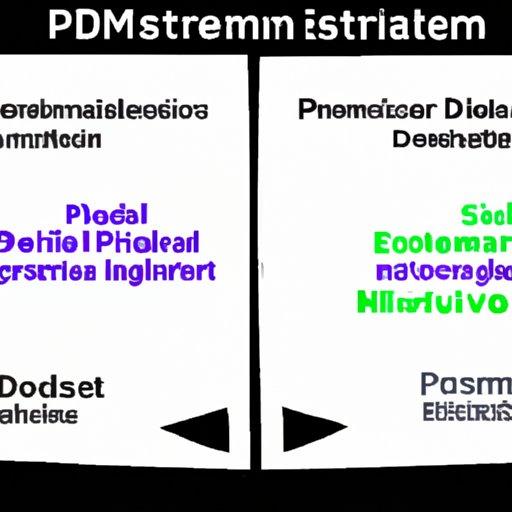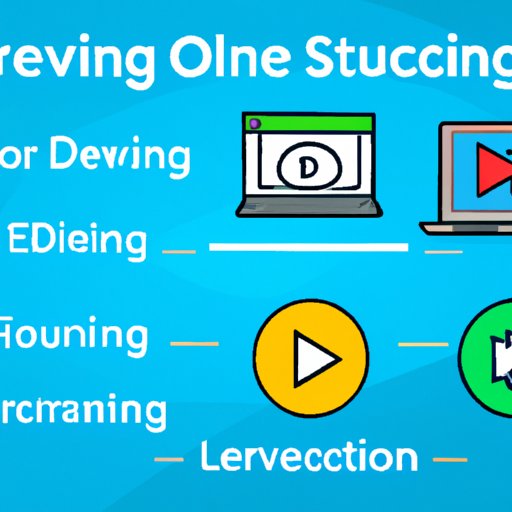Explaining the Technical Details of Streaming
Streaming is an increasingly popular way to consume media content. It refers to the process of delivering audio or video content over the internet in real-time. In other words, users can watch or listen to the content as it is being received from the source.
Understanding how streaming works requires knowledge of both the technical and practical aspects of the process. This article will explore these elements in detail.
Definition of Streaming
According to the Cambridge Dictionary, streaming is “the activity of watching or listening to something over the Internet as it happens, without having to wait for it to be fully downloaded.” This definition highlights the key feature of streaming – that it allows users to access content without having to download it first.
What is Needed to Stream?
In order to stream content, both the user and the streaming provider must have certain elements in place. For the user, this includes a device capable of connecting to the internet, such as a computer, smartphone, or tablet. Additionally, the user must have access to an internet connection with enough speed to support streaming.
For the streaming provider, they must have a server capable of hosting the content. This server must also be able to transmit the content over the internet in a format that can be played by the user’s device. Finally, the provider must have a delivery system in place that can reliably stream the content to the user.
How Does Streaming Work?
The process of streaming content starts when the user requests a piece of content from the streaming provider. The provider then sends the content to the user’s device in small chunks, or “packets”. These packets are sent over the internet and arrive at the user’s device in rapid succession. The user’s device then reassembles the packets into a single, continuous stream of content.
At the same time, the user’s device is sending feedback to the streaming provider. This feedback provides information about the user’s internet connection and device capabilities. The streaming provider uses this information to adjust the size and quality of the packets it sends to the user. This ensures that the user receives the best possible streaming experience.
Examining Different Types of Streaming Services
There are several different types of streaming services available today. Each type of service offers its own unique features and benefits.
Audio and Video Streaming Services
Audio and video streaming services allow users to access audio or video content on demand. Popular examples of these services include YouTube, Netflix, and Spotify. These services offer a wide selection of content that can be streamed at any time.
Live Streaming Services
Live streaming services allow users to stream content in real-time. Popular examples of these services include Twitch and Periscope. These services are often used for sporting events, concerts, and other live events.
On-Demand Streaming Services
On-demand streaming services allow users to rent or purchase content and then stream it whenever they want. Popular examples of these services include iTunes and Amazon Prime Video. These services offer a more limited selection of content than audio and video streaming services, but they often offer higher-quality content.
How to Choose a Streaming Service for Your Needs
When choosing a streaming service, it is important to consider a few key factors. These include cost, content offered, and user interface.
Consideration of Cost
The cost of streaming services can vary greatly. Some services are free, while others require a subscription or one-time fee. It is important to consider how much you are willing to spend on a streaming service before making a decision.
Consideration of Content Offered
Another factor to consider when choosing a streaming service is the content offered. Different services offer different types of content, so it is important to find a service that offers the type of content you are looking for.
Consideration of User Interface
Finally, it is important to consider the user interface of the streaming service. A good user interface should be easy to use and understand. It should also provide quick access to the content you are looking for.

Understanding Bandwidth and Video Quality when Streaming
When streaming content, it is important to understand how bandwidth and video quality can affect the streaming experience. Both of these factors can have a major impact on the quality of the streaming experience.
Understanding Bandwidth
Bandwidth is the amount of data that can be transferred over the internet in a given period of time. It is measured in megabits per second (Mbps). The higher the bandwidth, the faster the streaming experience will be. However, it is important to note that even with a high-speed internet connection, streaming can still be affected by other factors such as the number of devices connected to the network.
Understanding Video Quality
Video quality is another important factor to consider when streaming. Video quality is measured in terms of resolution and frames per second (FPS). Higher resolutions and higher FPS will result in a better streaming experience. However, higher resolutions and FPS will also require more bandwidth, so it is important to find a balance between video quality and bandwidth.

Analyzing the Pros and Cons of Streaming
Streaming has become increasingly popular in recent years, but it is not without its drawbacks. Understanding the pros and cons of streaming can help you decide if it is the right choice for you.
Pros of Streaming
One of the biggest advantages of streaming is its convenience. Streaming allows users to access content quickly and easily without having to wait for it to download. Additionally, streaming services often offer a wide selection of content that can be accessed at any time.
Another advantage of streaming is that it is typically cheaper than traditional media platforms. Streaming services often offer subscription plans that give access to a large selection of content for a low monthly fee.
Cons of Streaming
One of the biggest drawbacks of streaming is that it relies heavily on a reliable internet connection. Without a fast and stable connection, streaming can be unreliable and frustrating. Additionally, streaming services are often subject to buffering, which can disrupt the viewing experience.
Another potential downside of streaming is that it can be difficult to find content that is not available on the streaming service. This can be especially true for niche content or older films and television shows.

Comparing Streaming to Traditional Media Platforms
Understanding the differences between streaming and traditional media platforms can help you decide which is right for you. Here are some of the key differences between streaming and traditional media platforms.
Differences in Accessibility
One of the biggest differences between streaming and traditional media platforms is accessibility. Streaming services are typically more accessible than traditional media platforms, as they can be accessed anywhere with an internet connection. Additionally, streaming services often offer a wider selection of content than traditional media platforms.
Differences in Cost
Another difference between streaming and traditional media platforms is cost. Streaming services are typically cheaper than traditional media platforms, as they often offer subscription plans that give access to a large selection of content for a low monthly fee.
Differences in Quality
Finally, there are differences in the quality of the content offered on streaming and traditional media platforms. Streaming services often offer higher-quality content than traditional media platforms, as they are able to take advantage of newer technologies such as 4K and HDR.
However, it is important to note that the quality of the content offered on streaming services can vary greatly depending on the streaming service. It is important to research each streaming service to determine which one offers the best quality content.
Conclusion
Streaming is an increasingly popular way to consume media content. It is a convenient and cost-effective way to access a wide selection of content. However, it is important to understand the technical and practical aspects of streaming, as well as the pros and cons, in order to make an informed decision about whether or not streaming is right for you.
(Note: Is this article not meeting your expectations? Do you have knowledge or insights to share? Unlock new opportunities and expand your reach by joining our authors team. Click Registration to join us and share your expertise with our readers.)
